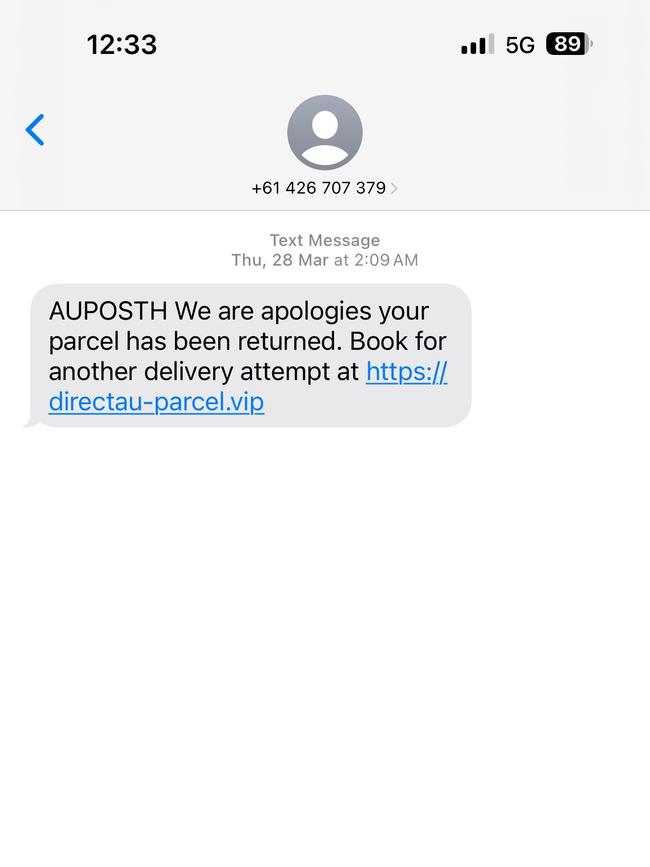Australians fall victim to new fake delivery, postage scams
Tess Stevens came face-to-face with a sneaky new scam that many millions of Australians are falling for. See how to spot the scams and tell us your experiences.

National
Don't miss out on the headlines from National. Followed categories will be added to My News.
Australians now receive shipping or package delivery scams far more than any other scam, with almost three quarters having received fake delivery or package scam messages on their phones.
More than a quarter of Australians admit they have also fallen victim to one of many postal scams, with a small number reporting losses exceeding $20,000.
The new data from Australia Post also found other common scams are linked to overdue tolls (49 per cent), winning a prize, money or holiday (39 per cent), a fake purchase (36 per cent), banking issues (31 per cent), telecommunications (26 per cent), unpaid taxes (22 per cent) and kids losing their phones (8 per cent).
Readers of this masthead also reported receiving scams “almost daily”, with little reprieve despite blocking the number or email address.


One reader said he had missed out on legitimate communications in the past because he was wary of scams.
“Just last month RACQ was trying to contact me on an insurance claim against me,” he said.
“It looked like a scam and I deleted it just to find out yesterday that it wasn’t a scam.
“The operator informed me I’m not the only one that has deleted emails and messages thinking that they are a scam.”
Another said Australia Post customers should look out for telltale signs of fraud in package tracking numbers, which could help filter legitimate information from foul play.
“Having the Australia Post app is the safest way to track genuine items sent through the post,” he said.
“(Australia Post) tracking numbers have a distinguishable pattern, anything from overseas will be 2-letters, 9 numbers and then the 2-letter country code of origin (CN-China, DE-Germany etc).
“Also the wording and structure of scam messages and emails are different to a genuine (Australia Post) notification. When in doubt, never click.”
Away from home, Australians are also falling for travel scams while on holiday with 73 per cent of victims losing between $100 and $2,000.


A report from security software company McAfee found while 83 per cent of Aussies are worried about protecting their phones, many admit to making common mistakes.
These include charging phones via public USB portals (40 per cent), checking Wi-Fi networks in accommodation before connecting (39 per cent), using social media to look up local attractions of restaurants (35 per cent) and post content (31 per cent), and they forget to log out of streaming accounts (32 per cent).
While the ACCC National Anti-Scam Centre reports Australians have reduced scam losses from $3.1bn in 2022 to $2.7bn last year, many people still don’t spot scams until it’s too late.
A reader of this masthead said blocking fraudulent messages had done little to stem their flow.
“It is just part of life,” the reader said.
“I receive the SMS and simply block the number. The same message will appear later the same week from another number. It happens almost daily.
“I know what my expenses are and when my bills are due. If I get an SMS claiming to be a company I know I do business with that vaguely could be relevant I will not respond, but log in to the company via my normal means and double check.
“99 per cent of the time they are scams.”
Other common scams are linked into investments, romance, phishing and payment redirection.
Australia Post chief executive Paul Graham confirmed Australia Post will never call, text, or email its customers asking for personal or financial information such as passwords or credit card details.
“Australians are losing billions of dollars to scams each year. Scam attempts are becoming more sophisticated, frequent and increasingly harder to detect, and our latest research reveals that most of us have already been targeted,” Mr Graham said.

Sydney woman Tess Stevens, 28, recently came face-to-face with a sneaky new parcel delivery scam, clicking through and realising what it was at the last second.
The retail worker ordered new shoes online, which were to be delivered via Australia Post right before she was set to go on holiday, so she was hoping she could pack them.
“I got a message from Australia Post saying they’d tried to deliver the parcel and weren’t successful,” she said. “It had a link that took me to a website that looked really believable.
“Then I had to log into my account and then it asked for $5 to release the parcel.”

Alarm bells sounded, and when she entered her tracking number into the Australia Post app, she saw the package was still in transit and that no delivery attempts had been made.
“It’s such a small amount,” she said. “You’re excited to purchase something online, and if you were waiting to go away, you wouldn’t even think about paying $5 to have it released.
“The fact that they could hunt down my phone number in the first place is a bit scary.”
The National Anti-Scam Centre is urging people to “stop and think, don’t click the link”.
“Our advice to consumers is to never click on links in text messages or emails, even if you’re expecting a delivery,” ACCC deputy chair Catriona Lowe said.
“Instead, consumers should independently check the status of their delivery by going to the Australia Post app or website, or the courier service they’re expecting the delivery from.”
Many scam texts target wide groups of people, rather than exploiting the data of individuals.
Another reader of this masthead said they were exposed to spam that was regularly inaccurate to their circumstances.
“I’ve had a couple of texts warning that my Coles points are expiring today,” he said.
“Red flag! I don’t shop at Coles.”
“The parcel delivery texts have been coming at 2-3am, so there’s another red flag.
“(And) I live 200 km from the nearest toll road, so those are obviously false.”
HOW TO SPOT A MAIL SCAM
The ACCC said there are three main things to look for when identifying a scam.
The first is receiving a text message or email.
The second is that the text or email contains a link asking you to provide personal information or a payment.
These will usually click through to a website that looks official but is not.
The third is a sense of urgency. Scammers try to create a sense of urgency to pressure you to do something quickly, such as entering personal details, without realising it’s a scam.




